
by Harvey Leifert Wednesday, December 14, 2016
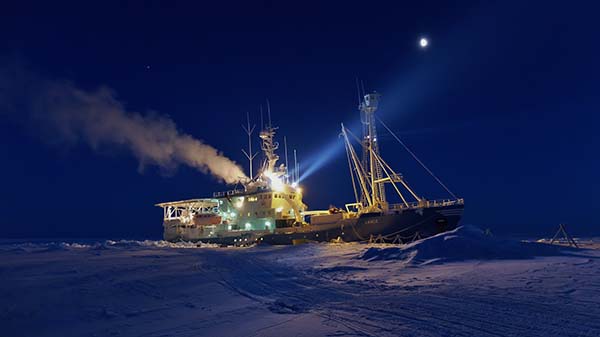
The Norwegian research vessel Lance wintered in the sea ice from January to June 2015. Credit: Monica Votvik/Norwegian Polar Institute
“Extremes define the Arctic.” With that observation, Mats Granskog of the Norwegian Polar Institute (NPI) began a tale of recent discoveries about change in the Arctic, resulting from and also causing climate change. Speaking to reporters in advance of scientific sessions at the American Geophysical Union’s fall meeting in San Francisco on Dec. 13, Granskog and colleagues described results of the Norwegian Young Sea ICE Expedition (N-ICE), a unique project that reached as far as 83 degrees north.
The Norwegian research vessel Lance, assisted by Norwegian Coast Guard vessels, penetrated north of Svalbard to within 800 kilometers of the North Pole and wintered in the sea ice from January to June 2015. More than 70 scientists from 10 countries called the Lance home and endured harsh conditions to conduct experiments that had never before been done on site, especially during the dark polar winter.
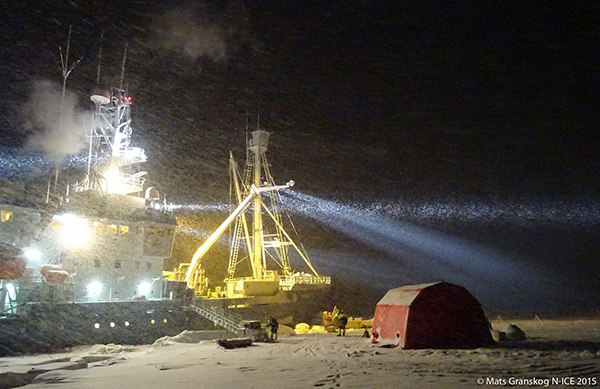
Researchers worked on the ice, sometimes several kilometers away from the ship. Credit: Mats Granskog/Norwegian Polar Institute
What they found surprised them, Granskog said: “drastic changes” resulting in what he called the “new Arctic” that call into question the state of scientists’ knowledge of Arctic sea ice. For instance, he said, the ice, even in winter, was much thinner than the Arctic we knew just 20 years ago, just a meter or so thick in places. This ice behaves much differently from older, thicker ice, the scientists found. It moves faster, cracks more easily, and is more susceptible to damage from storms and winds. The ice was so thin that in places it was flooded by seawater, as the weight of snow — much more than scientists had anticipated — pushed the ice below the water’s surface.
Amelie Meyer, an oceanographer at NPI who studied the ocean below the ice for 12 weeks aboard the Lance, said the Arctic Ocean waters are warmer than scientists thought, and the warmest waters normally lie far below the surface. Storms — more violent and more frequent than expected — stirred the ocean waters, even where ice was present. That action brought warmer water, with temperatures up to 4 degrees Celsius, closer to the surface and helped melt the ice from below.
“In winter, the ice melted a few inches from below, which is already significant when you only have a few feet,” Meyer said. “But in the summer the numbers were just huge, with as much as 10 inches of ice melt a day from below,” she said. “When you’re standing on just three feet of ice, that doesn’t give you many days before things become interesting.”
Meyer described a crack in the ice that widened rapidly near the ship, stranding scientists and equipment on what became separate ice floes. Team members and the equipment and data were recovered using a small boat.
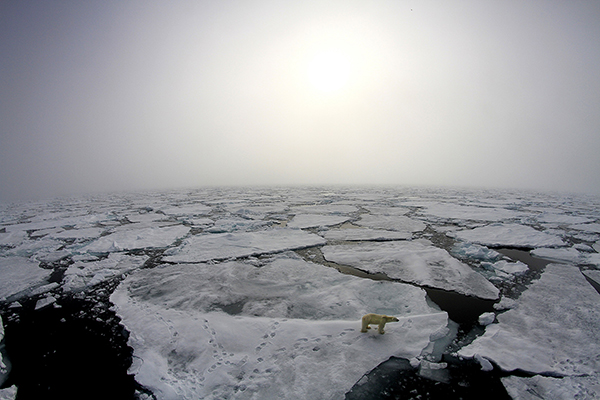
The N-ICE researchers found fragile sea ice, sometimes just a meter thick, easily broken up by the wind and waves of winter storms. Credit: Marcos Porcires/Norwegian Polar Institute
The upwelling of warmer water also brought nutrients toward the surface, where they helped nourish the first phytoplankton blooms ever detected under snow-covered Arctic ice. Light transmission through the thin ice helped the blooms to develop, Meyer reported. Typically, blooms absorb carbon dioxide and sink to the deep ocean where they sequester the carbon, but these algae did not sink far, Meyer said, and therefore did not help export carbon to the deep ocean.
Scientists aboard the Lance also studied the atmosphere above the Arctic ice. Von Walden of Washington State University spent a month investigating the effects of winter storms on the young thin ice. One big finding was the presence of either total cloud cover or none at all, with no instances of broken clouds during the time he was aboard the Lance, Walden said. That was similar to a finding made on the SHEBA expedition in the Pacific Arctic, the only previous winter observations of the central Arctic ice pack.
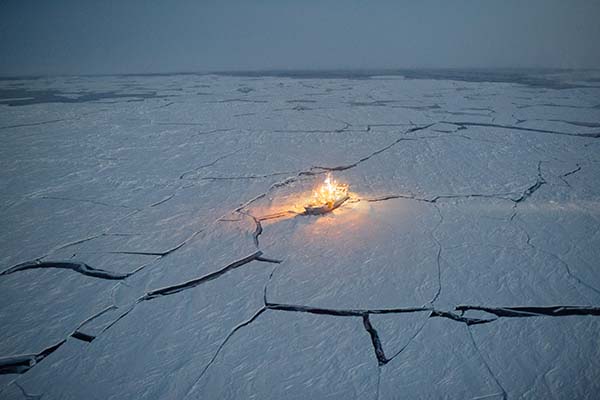
The Norwegian research vessel Lance penetrated north of Svalbard to within 800 kilometers of the North Pole. Credit: Nick Cobbing/Norwegian Polar Institute
Walden focused on storms and their effects, which were not similar to those experienced by the SHEBA team 20 years ago. The storms observed in 2015 were transported by an anomalous and powerful jet stream that pushed them from the warmer North Atlantic into the high Arctic. These conditions had been modeled, but never before observed, Walden said. The winds accompanying storms stress the thin ice and help break it up, Walden said. In February 2015, the winter Arctic sea-ice maximum extent was the lowest ever measured to that point since satellite observations have been made. (This record low was eclipsed in March 2016.)*
That same month, the team experienced a storm that raised the air temperature from minus 40 degrees Celsius to zero degrees in under 48 hours. The wind, which had been calm, reached over 80 kilometers per hour, the humidity increased by more than a factor of ten, and the largest snowfall of the entire six-month expedition was recorded. The extent of snowfall in the Arctic Ocean is not well established, Walden said, so the N-ICE measurements are important.
Arctic amplification, the feedback process that affects climate more rapidly in the far north than in lower latitudes, was observed directly, Granskog said. The thin ice and open waters absorb heat, rather than reflecting it back into space as thick ice would. It thereby contributes to the greenhouse effect, and the cycle repeats.
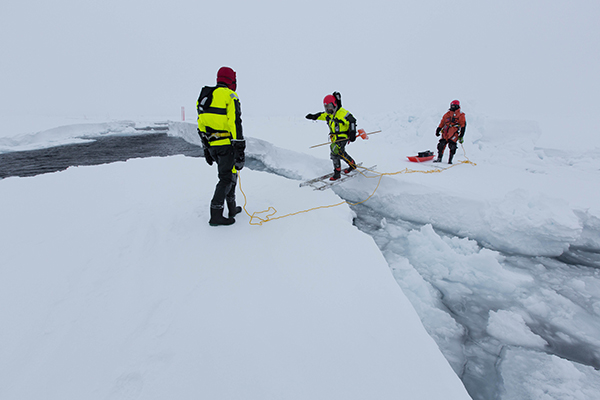
Scientists making winter observations in the Arctic in 2015 often faced treacherous conditions. Credit: Tor Ivan Karlsen/Norwegian Polar Institute
“Scientists still have a lot to learn about the Arctic,” Walden said. “Researchers have consistently underestimated how rapidly Arctic sea ice will decrease as a result of significant climate change in this region, part of this is due to the fact that there are so few observations during critical times of the year, including the winter.”
Despite the dangers posed by the weather, the thin ice, and curious polar bears, the N-ICE scientists persevered and amassed unprecedented data on conditions in the new Arctic. “It was no simple ordeal,” Granskog said. But “the changes in the Arctic will affect everyone on the planet, so understanding how the Arctic functions and [predicting] its future is very important.”
* Jan. 26, 2017: This story was updated to note that the record low Arctic maximum sea-ice extent measured in February 2015 was surpassed by a new record low in March 2016.
© 2008-2021. All rights reserved. Any copying, redistribution or retransmission of any of the contents of this service without the expressed written permission of the American Geosciences Institute is expressly prohibited. Click here for all copyright requests.